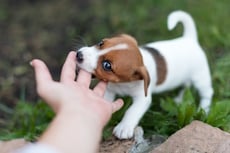 As much as we adore our furry companions, it’s essential to remember that dogs are animals with instincts and behaviors that can sometimes lead to unfortunate incidents, like dog bites. Preventing dog bites requires responsible pet ownership and understanding the factors that contribute to such incidents. In this blog post, we’ll explore three crucial steps to help you prevent dog bites: socializing your dog from a young age, teaching your dog bite inhibition, and being aware of your dog’s body language.
As much as we adore our furry companions, it’s essential to remember that dogs are animals with instincts and behaviors that can sometimes lead to unfortunate incidents, like dog bites. Preventing dog bites requires responsible pet ownership and understanding the factors that contribute to such incidents. In this blog post, we’ll explore three crucial steps to help you prevent dog bites: socializing your dog from a young age, teaching your dog bite inhibition, and being aware of your dog’s body language.
Socializing Your Dog from a Young Age
Early socialization plays a vital role in shaping your dog’s behavior and temperament. By introducing your furry friend to various environments, people, and other animals during their critical developmental period, typically between 3 to 16 weeks of age, you can help them become more comfortable and confident in different situations. Here are some tips to effectively socialize your dog:
- Puppy Classes: Enroll your pup in puppy classes where they can interact with other puppies in a controlled and supervised setting. This helps them learn appropriate play behaviors and communication skills.
- Positive Exposure: Introduce your dog to different sights, sounds, and experiences positively. Gradually expose them to new environments, such as parks, busy streets, and cafes, rewarding them with treats and praise for calm and friendly behavior.
- Meeting New People: Allow your puppy to interact with a variety of people, including adults, children, and individuals wearing hats or sunglasses. Ensure these interactions are positive and gentle to build their trust and confidence.
- Supervised Playdates: Organized playdates with other well-behaved and vaccinated dogs. Supervision is crucial during these encounters to prevent any aggressive behavior from escalating.
Teaching Your Dog Bite Inhibition
Bite inhibition is the ability of a dog to control the force of their bite, and it is a critical skill for every canine to learn. Puppies often learn this from their littermates during play, but it’s essential to reinforce this behavior during their training. Here are some methods to teach dog bite inhibition:
- Positive Reinforcement: Whenever your dog demonstrates gentle mouthing during play, praise and reward them with treats. Positive reinforcement reinforces the behavior you want to encourage.
- Avoid Rough Play: Avoid engaging in rough play that might encourage your dog to use their mouth aggressively. Instead, opt for games that promote gentle behavior, such as fetch or tug-of-war with soft toys.
- Consistent Feedback: When your dog bites too hard during play, provide immediate feedback with a firm “No” or “Ouch” and stop the play session momentarily. This helps your dog understand that biting too hard leads to the end of playtime.
- Time-Outs: If your dog continues to bite hard even after the feedback, give them a brief time-out in a quiet and separate area. This reinforces that rough play leads to a loss of fun interaction.
Being Aware of Your Dog’s Body Language
Bite inhibition is the ability of a dog to control the force of their bite, and it is a critical skill for every canine to learn. Puppies often learn this from their littermates during play, but it’s essential to reinforce this behavior during their training. Here are some methods to teach your dog bite inhibition.
- Tail Position: A wagging tail doesn’t always mean a happy dog. A high and stiffly wagging tail can indicate excitement or arousal, which might lead to aggression. Conversely, a tucked tail signals fear or anxiety.
- Ears: Pay attention to your dog’s ears’ position. Forward and relaxed ears indicate a friendly demeanor, while flattened or pinned-back ears suggest fear or stress.
- Eye Contact: Direct, unblinking eye contact can be seen as a challenge or threat in the dog world. Avoid staring at dogs you don’t know and teach children to avert their gaze if they encounter an unfamiliar dog.
- Growling and Snapping: Growling and snapping are clear signs that a dog feels uncomfortable or threatened. If your dog displays these behaviors, remove them from the situation and address the underlying cause of their distress.
What To Do if You Encounter an Aggressive Dog
Even with all the preventive measures in place, there may be times when you encounter an aggressive dog, whether it’s a stray or one belonging to someone else. In such situations staying calm and following these steps can help you handle the situation safely:
- Stay Still and Calm: If you come across an aggressive dog, avoid making sudden movements or loud noises. Stand still and keep your arms by your side. Speak calmly and softly to the dog without making direct eye conduct.
- Don’t Run: Running away from an aggressive dog may trigger their prey drive, making the situation worse. Instead, slowly back away while keeping the dog in your peripheral vision.
- Create Distance: Use objects like umbrellas, backpacks, or jackets to put some distance between you and the dog. These items can act as a barrier without provoking further aggression.
- Use a Diversion: If the dog’s owner is nearby, ask them to call their dog back. You can also try tossing a treat or a toy away from you to divert the dog’s attention.
- Seek Higher Ground: If the aggressive dog is a large breed and you can find a nearby car or sturdy object to sand on, do so. This can provide some protection and reduce the chance of the dog jumping on you.
- Protect Your Face and Neck: If the dog attacks, protect your face and neck by curling into a ball and covering these areas with your arms and hands.
- Report the Incident: After the encounter, report the incident to the local animal control or police, providing a description and location of the aggressive dog. This action can help prevent future incidents with the same dog.
Create a Safer Environment for You and Your Canine Companion
Preventing dog bites requires a combination of responsible pet ownership, proper training, and understanding canine behavior. Socializing your dog, teaching bit inhibition, and being aware of their body language are fundamental steps to fostering a friendly and safe canine companion. Additionally, knowing how to handle encounters with aggressive dogs and promoting responsible ownership in the community is essential for creating a harmonious environment for all.
By taking these preventive measures and being a responsible dog owner, you can contribute to a safer and more enjoyable experience for both you and your beloved four-legged friend. Remember, being proactive in preventing dog bites is key to building strong bonds and lasting memories with your canine companion. Together, we can make the world a better place for dogs and humans alike!
Discover effective strategies for preventing dog bites or schedule an appointment with Hampton Park Veterinary Hospital to learn more. Our friendly and professional staff is here to assist you.

